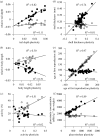Re-evaluating the costs and limits of adaptive phenotypic plasticity
- PMID: 19846457
- PMCID: PMC2842679
- DOI: 10.1098/rspb.2009.1355
Re-evaluating the costs and limits of adaptive phenotypic plasticity
Abstract
When the optimal phenotype differs among environments, adaptive phenotypic plasticity can evolve unless constraints impede such evolution. Costs and limits of plasticity have been proposed as important constraints on the evolution of plasticity, yet confusion exists over their distinction. We attempt to clarify these concepts by reviewing their categorization and measurement, highlighting how costs and limits are defined in different currencies (and may describe the same phenomenon). Conclusions from studies that measure the costs of plasticity have been equivocal, but we caution that these conclusions may be premature owing to a potentially common correlation between environment-specific trait values and the magnitude of trait plasticities (i.e. multi-collinearity) that results in imprecise and/or biased estimates of the costs. Meanwhile, our understanding of the limits of plasticity, and how they may be underlain by the costs of plasticity, is still in its infancy. Based on our re-evaluation of these constraints, we discuss areas for future research.
Figures


Comment in
-
Measuring the cost of plasticity: a problem of statistical non-independence.Proc Biol Sci. 2011 Sep 22;278(1719):2724-5; discussion 2726-7. doi: 10.1098/rspb.2011.0595. Epub 2011 Jun 22. Proc Biol Sci. 2011. PMID: 21697175 Free PMC article. No abstract available.
References
-
- Agrawal A. A.2001Phenotypic plasticity in the interactions and evolution of species. Science 294, 321–326 (doi:10.1126/science.1060701) - DOI - PubMed
-
- Agrawal A. A., Conner J. K., Johnson M. T. J., Wallsgrove R.2002Ecological genetics of an induced plant defense against herbivores: additive genetic variance and costs of phenotypic plasticity. Evolution 56, 2206–2213 - PubMed
-
- Berrigan D., Scheiner S. M.2004Modeling the evolution of phenotypic plasticity. In Phenotypic plasticity: function and conceptual approaches (eds DeWitt T. J., Scheiner S. M.), pp. 82–97 New York, NY: Oxford University Press
-
- Bradshaw A. D.1965Evolutionary significance of phenotypic plasticity in plants. Adv. Genet. 13, 115–155 (doi:10.1016/S0065-2660(08)60048-6) - DOI
-
- Callahan H. S., Pigliucci M.2005Indirect consequences of artificial selection on plasticity to light quality in Arabidopsis thaliana. J. Evol. Biol. 18, 1403–1415 (doi:10.1111/j.1420-9101.2005.00963.x) - DOI - PubMed
Publication types
MeSH terms
LinkOut - more resources
Full Text Sources

